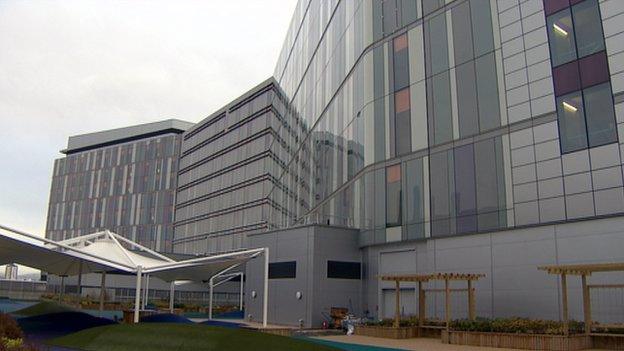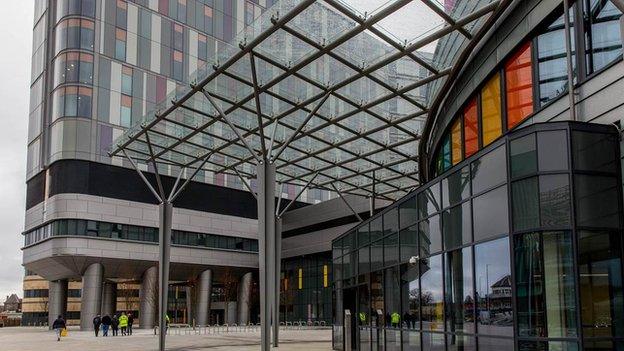Emergency waiting times rise in main Glasgow hospitals
- Published

The Queen Elizabeth University Hospital had recently been making progress in cutting A&E waiting times
Glasgow's two main hospitals widely missed accident and emergency waiting time targets at the start of January.
In the week to 10 January only 75.9% of patients, external were treated within the four hours at the Queen Elizabeth University Hospital (QEUH), its worst ever figure.
The figure for Glasgow Royal Infirmary (GRI) was 76.3%, also well below the Scottish government's 95% target.
Across Scotland the average was 88.3%, with 85 patients waiting more than 12 hours in A&E.
It was the second week in a row that Scottish hospitals fell short of the target.
The period covered, just after the Christmas break, is a traditionally busy one for A&E departments.
There were 24,161 attendances at emergency departments. A total of 527 patients waited more than eight hours.
A&E patients treated within 4 hours
95%
Scottish Government target
-
75.9% Queen Elizabeth University Hospital
-
76.3% Glasgow Royal Infirmary
-
88.3% Scotland average
The Scottish government said it was likely to have been the most demanding week of the year for Scottish hospitals.
And it pointed out that the Scotland-wide figures represented a five percentage point improvement on the same week last year.
Health Secretary Shona Robison said: "This is a time of substantial increased pressure on our NHS.
"We know from previous experience that these weeks are always the period when the performance of our A&E departments are affected most significantly.
"This week's figures show just how much A&E performance can fluctuate, not only from week to week, but also from hospital to hospital, particularly at this time of year."
She added: "Our clear focus is now on supporting boards and hardworking staff to ease pressure across the system. We have already invested some £10.7m to help cope with extra winter demand and we have been providing expert support for boards where required."

Patients waiting more than 12 hours in A&E

University Hospital, Ayr - 11
University Hospital, Crosshouse - 15
Victoria Hospital, Fife - 9
Glasgow Royal Infirmary - 12
Hairmyres Hospital - 14
Wishaw General Hospital - 21
Royal Infirmary of Edinburgh - 2
Queen Elizabeth University Hospital - 1
Source: ISD Scotland, week to 10 January

Scottish Labour said the figures showed that NHS staff were being overstretched "week in, week out".
Public services spokesperson Dr Richard Simpson said: "Now more than ever we need a health service based on patient need, not the ability to pay, with the resources it needs to deliver the care Scots deserve.
"We know that only a third of NHS staff think they have the support and the resources to do their jobs properly. This is the result of the SNP cutting the health budget.
"We need to move away from crisis management in our NHS to a plan for the long term."
The QEUH, a £842m "superhospital" which replaced four other hospitals, had previously enjoyed some success in cutting waiting times after repeatedly missing targets since opening in April 2015.
In June, the Scottish government announced that a team of experts would be sent in to help staff improve A&E waiting times at the site.
At the start of December it met the 95% target and only narrowly missed it during the Christmas fortnight.
NHS Greater Glasgow and Clyde (GGC) said such figures were by their nature subject to wide fluctuations but were generally 10% better than they were a year ago.
A spokesperson said: "Whilst this latest published weekly data shows a dip in performance we are pleased that the current performance across GGC remains consistently better than the same period last year.
"Our position this week shows that 6,518 out of a total of 7,269 patients were seen, treated and either admitted or discharged within the four-hour target.
"We are confident that all of the steps being taken at our sites will continue to see sustained improvements."
- Published13 October 2015

- Published20 October 2015
